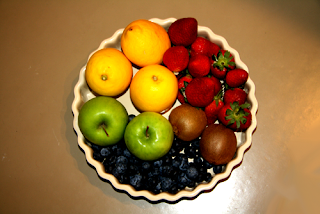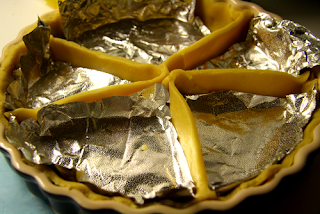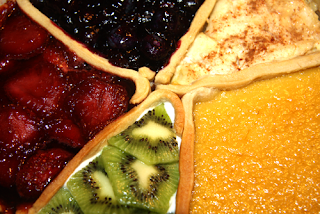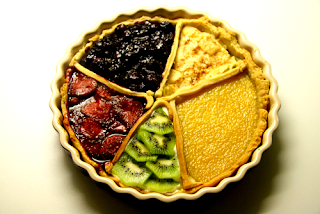 I should probably hang up my keyboard and cease blogging. I think I've reached the pinnacle of my baking career. And at such a young age, too.
I should probably hang up my keyboard and cease blogging. I think I've reached the pinnacle of my baking career. And at such a young age, too.This week, I made a pie chart pie.
This all came about because I work in a place where being geeky makes you cool. We like statistics and frequency tables and regressions. And yes, pie charts too. Last week I was creating some pie charts for a report, and a silly Friday afternoon conversation led me to wonder if it would be possible to actually create a pie in pie chart form. So I took a poll of colleagues' fruit preferences, and decided to attempt a pie that would show the results in their correct proportions. Lemon turned out to be most popular, with 4 votes, followed by 2 each for strawberry and blueberry, and 1 each for apple and kiwi.
 I'm not going to provide step by step instructions, because I'm not sure who else would be crazy enough to try and make this. I decided not to google it before I made it, because it would have been disappointing to find out that this wasn't an original idea. But when I did search the internet for it after it was done, I discovered that I am probably the first person to have thought of doing this. I'm going to have to look into copyright!
I'm not going to provide step by step instructions, because I'm not sure who else would be crazy enough to try and make this. I decided not to google it before I made it, because it would have been disappointing to find out that this wasn't an original idea. But when I did search the internet for it after it was done, I discovered that I am probably the first person to have thought of doing this. I'm going to have to look into copyright!However, should you ever try and recreate this for yourself, my method was to start by making the dough for pie crust (any recipe for shortcrust will do - I went with the one I used recently for tarte tatin) and chilling that in the fridge for half an hour or so. Then roll it out and use it to fill a flan dish, making sure that the pastry comes up and slightly over the edges of the dish. With the extra dough, fashion small walls to divide up the segments, and push them into the base of the pie. You could use beaten egg or milk to help fix them in place, but I decided to just treat the pie crust like plasticine and mould it by hand, and it worked fine. Then cut out pieces of tin foil large enough to fit in each segment, and weigh down with baking beads. Cook the pie crust for about half an hour in an oven pre-heated to 180 degrees, remove and leave to cool completely before filling.

What you use for filling is entirely your own choice. I would recommend the following for lemon, blueberry, strawberry, and kiwi (adjusting for the quantity needed for each segment) but there are lots of good recipes out there that would work just as well.
Where it gets tricky is the timing. For my pie, the lemon curd and the apple needed to be in the oven for 25-30 minutes, but the strawberry only needed 6-8 minutes, and the blueberry and the kiwi weren't supposed to be cooked at all. However, if you leave foil in those segments the pie crust shouldn't burn, and you can fill them afterwards when the rest of the pie has cooled.
 And you know what? It was a lot of work. It took about three and a half hours to make. But it was all worth it for the reaction of all my lovely colleagues and friends. I'm very glad to know people who think that an endeavour like this isn't completely insane, and enable me in my culinary ambitions.
And you know what? It was a lot of work. It took about three and a half hours to make. But it was all worth it for the reaction of all my lovely colleagues and friends. I'm very glad to know people who think that an endeavour like this isn't completely insane, and enable me in my culinary ambitions.Now thinking of starting a side-business called Pie Squared...there must be a market for statistical baked goods out there!
























